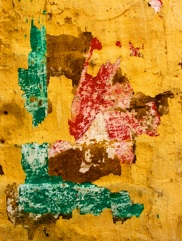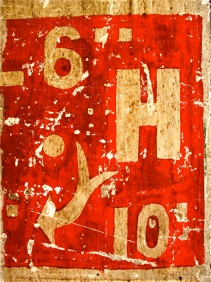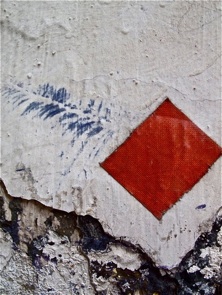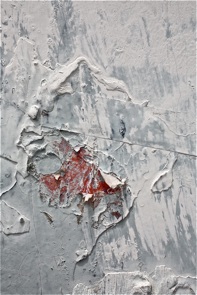Unnoticed p Home
The distinctions between photography and ‘art’ are cause for frequent debate, particularly among painters and photographers themselves, but it sometimes seems an irrelevant discussion. Is photography art? It is safe to say most would accept it as a major art but that painters are held in different esteem, assumed to hold skills unassisted by technology, that the photographer may not. Yet it is likely that many great painters would agree that their greatest skill – or ‘tool’ – is their eyes, not their fingers. And the particular vision an artist possesses can be manifested through the lenses of a camera, the application of paint on a surface, the moulding of clay or hewing of stone, or indeed, many other media. When a photographer’s vision is doubly trained by the parallel experience as a painter, the world expects particular sharpness, and a unique perspective.
Norman de Brackinghe has painted fine watercolours for years, but his recent exhibition at Shaw College, Chinese University of Hong Kong, was of photographs, in a show called ‘unnoticed’. What interests us – the architectural character of the new work – may not have been what compelled Norman to shoot the pictures in the first place, given his background. For what distinguishes these compositions most strongly is their abstract, painterly quality. Almost to a one, the photographs are in the first reading scale-less and unrecognisable representations. Many are difficult to define even upon protracted observation, some convince the observer they are indeed modern paintings. What they are is close-up shots of surfaces- architectural surfaces essentially – first recognised, then captured as compositions of colour and shape and line that are accidentally beautiful. And right there that distinguishes them from deliberate paintings. It is Mr. de Brackinghe’s eye and sees these opportunities in the more bedraggled surfaces of a city such as ours, and it is his watercolour-trained compositional sensibility that then knows how to find the right light, angle, frame to bring out their sample visual pleasures. The results might have a few painters gazing with fascinations … even envy.
Reproduced by kind permission of Hinge Magazine
Volume 115
February 2005
Great Walls
Henry Steiner
Managing Director, Steiner & Co

Norman de Brackinghe is like the rag picker, in a poem by Baudelaire, who finds treasures where the common eye sees only trash. Baudelaire’s scavenger is a metaphor of the artist and de Brackinghe has transformed the photography of visual accidents on derelict walls into an art form.
De Brackinghe is not an eccentric gweilo amateur wandering the less travelled streets of Hong Kong ; his eye and hand are formally trained. He worked as a printing production expert with experience at Allen Lane/Penguin in London and Paul Hamlyn in Hong Kong. He is also an exhibited water colourist in the English tradition of misty landscapes in precisely rendered colours.
In 2000, he ran into his first wall with a convergent explosion that still reverberates and informs his work. His digitally enlarged colour prints have been successfully exhibited at our Chinese University and in Cambridge England. People respond positively to his wall work for two reasons, I believe.
For one, de Brackinghe’s images are bright, witty, surprising, stimulating and above all, brilliantly coloured. I have seen many other photographs of broken surfaces, torn posters and splattered paint, but they are depressing with a subtext of the sadness of time’s passage and degradation. His are bright and radiate that life energy the Chinese call chi.
Secondly, his images are aesthetically informed, betraying de Brackinghe’s study of Dada collages and Abstract Expressionism. These photographs recall Schwitters, Rothko, Motherwell, Rauschenberg while even outstripping their influence. From accident, obliteration, scrawl and neglect has come an art which captures Hong Kong’s energetic, distinctive personality.
Reproduced by kind permission from The Peak Magazine
Vol 3 No. 5
May 2006
In Defence of Decay
John Batten

“Photography has always been fascinated by social heights and lower depths…”
- Susan Sontag (On Photography, Penguin Books 1971)
Decay, decrepitude, shabbiness, ruin, collapse, scruffiness, grunginess, dirtiness… words extracted from the thesaurus and all rightly associated with Norman de Brackinghe’s Great Walls photographs.
Photography discovered early on that there was great beauty in shabbiness and the world’s underbelly: Francis Frith’s ruins of Egypt, Eugene Atget’s tatty Paris streets, Weegee’s cold dramatic murder spots, John Thomson’s noble London tradesmen, Jacob Riis’ New York poor, Walker Evans’ signage. Photography’s history is almost a roll call of aesthetic investigations of a type that ‘painters of beauty’ tended to avoid and it was only after Pop Art’s anything goes attitude that there have been depictions of subjects that photography had already been depicting for a century.
Norman’s photographs of a variety of distressed surfaces join this photographic continuum – yes, the viewer can identify rust, tattered posters, road markings and when we hover daze-like in the street we notice the beauty. Norman’s documentation of these scenes is both a reminder of the intrinsic beauty of these common street views and that his abstract depictions are themselves arrestingly beautiful – and, done in the defence of decay.
From the catalogue of ‘Great Walls’
2006
The Art of The Abstract
Arthur Hacker

A thorough search from Abstract Expressionism to Zoomorphic Ornament yielded little useful material although the book is bursting with thousands of strange words, most of which end with the letters “-ism”, that art critics use to bewilder their readers. I was looking for an established art term that I could use in this article to describe the beautiful pictures by Norman de Brackinghe chosen for his photographic exhibition entitled Eyes Wide Open (shown in the FCC in November).
The art term Abstract Expressionism which is sometimes known as Action Painting, is the technique that was used by the American painter Jackson Pollock in his “drip painting” period. The difference between Pollock’s drip painting and Norman de Brackinghe’s photograph entitled Perth W.A. 2007 is that Pollock created his drips by throwing paint at a canvas, whereas Norman’s image had already been created by nature on an obscure wall in Australia.
Early in the last century there was a group of artists, which included Graham Sutherland and Paul Nash, who would find a natural object with an interesting shape and use it as an image in painting. This was called an objet trouve which in French means a ‘found object”.
When I was a student in London in the 1950s, instead of using the American term Abstract Expressionism we used the French generic term tachisme. I think that it would therefore be appropriate to christen Norman de Brackinghe’s school of photography as tachisme trouve.
It is an oversimplification to describe Norman’s work as photographs of montages that have been created by nature. Unlike the chaotic violence of the Abstract Expressionists and the surrealist paintings of the Objet Trouve brigade, whose work was designed to disturb, Norman strives to achieve visual harmony in his photographs.
His sense of balance is superb. He has a natural eye of a born artist and an impressive sense of colour and tone. As a photographer he is a purist who is inspired by the old-fashioned ethics established by the likes of Henri Cartier-Bresson, who insisted on printing all his photographs full-neg without any cropping.
Norman does not crop his pictures either. In spite of them being digital, he does not fall into the trap of unnecessary computer manipulation. Neither does he deliberately change any colour. He is also fanatical about using the finest quality archival inks and paper.
As a photographer Norman is an idealist who feels impelled to work within a structure of aesthetic and technical self-imposed rules. Self-discipline of this sort is not unusual among artists, photographers and architects.
When I have a graphic design problem which requires a modest amount of harmony, I tend to plan it carefully according to the Golden Section (known as the Divine Proportion by the Renaissance painters). Over half a century ago I was fortunate at the Royal College of Art by the great guru of dynamic symmetry, Professor Matila Ghyka.
One of Norman’s photographs is of a while rectangle on top of a blue squarish shape. It is a beautifully balanced composition that is almost, but is not quite, a classical Golden Section rectangle.
Most of us, from time to time, have taken the odd quasi-abstract photograph. Maybe we were inspired by pattern, natural or man-made, or a mixture of both that has delightfully aged and changed over the passage of time. It could be anything from a detail on the Berlin Wall, a moss-encrusted letter on an ancient gravestone or a mutilated poster of Chairman Mao.
Norman likes taking detailed close-ups of pattern that has received a bashing from Old Mother Nature. His sense of balance is so fine that his pictures give you a feeling of utter peace. When you consider his basic subject matter, it is not easy to understand how he achieves this. His selection of raw material may seem eccentric, unreal and incomprehensible when compared to the finished picture.
How he manages to create a feeling of sublime peace by photographing close-ups of decaying rubbish may be bewildering if you forget that the end result is a beautiful abstract picture.
It is easy to forget that patina is the beautiful incrustation of the surface of old bronze which is valued by the positive romantic thinker, whereas the cynical negative thinker may classify it merely as putrefaction. It takes someone like Norman to reveal its hidden beauty through the medium of abstract photography.
Reproduced with the kind permission from The Correspondent Magazine
March-May 2008
Juxtapositions
and contradictions
Edited from an article by John Batten from Perspective Magazine, November 2010
What’s old, grimy and broken down to the naked eye can sometimes be transformed by the simple act of capturing it on camera
Hong Kong is not good at nuance: subtle variations get lost in the pace of this place and there is – like much of the world at the moment – a feeling that big and bold and noisy is best. Slowing down, however, is the key to seeing little objects around us, layers of nuanced, overlooked and subtle beauty.
Norman de Brackinghe’s recent Texture photography exhibition shows distressed surfaces and textured walls. Closely photographed these walls resemble a casual assemblage or a strongly gestural abstract painting: the physical residue of a wall’s paint and adhered objects worn and eroded over time.
The Japanese term fuuka refers to this weathered look and its appreciation in Japan can be seen in design and architecture, rusted steel surfaces are especially common. Ueki Keiko, curator at the Suntory Museum in Osaka, says that fuuka is one of the aesthetic notions of Japan and rather than evoking a negative sentiment, regret or dissent with natural principles it is degeneration, corrosion and decay that evoke a warm affection.
The keenest appreciation for the old and worn in Hong Kong is seen in the city’s older areas: for example, a chair repaired – seemingly beyond repair; to keep an old object means that fate and luck is not tempted to change. Sentiments such as this are, of course, sentimental or superstitious, rather than an aesthetic appreciation of the object’s weathered patina.
The photographs in de Brackinghe’s exhibition are beautiful and so are the actual physical walls that he has photographed. His framed photograph is appreciated as a beautiful art object, whereas the actual wall struggles to be treated as anything but an old and dirty wall. This juxtaposition, or confusion, of emotions indicates that being aesthetically objective is difficult, but it also adds another element: value.
Reprinted by kind permission of the author.
Impermanence
John Batten

Hong Kong’s changing urban landscape makes Norman de Brackinghe bristle, “There seems to be an insistence on the destruction of neighbourhoods, which is absolutely unnecessary. Parks are concreted and grass is only somewhere for insects to live. The problem, I am afraid, is much worse than people imagine.”
Armed with his camera, de Brackinghe’s long walks through Hong Kong’s older areas witness a battlefield of redevelopment. “Wherever you go, large buildings in the process of erection and their hoardings advertising the future, block the way. There is absolutely nothing remotely holistic about this planning - whole neighbourhoods get trampled under foot.”
It is in these older areas that de Brackinghe finds the subtle, human interaction with the environment that filters back as a subject in his photographs – simple ephemeral residues of human activity, such as layers of paint, peeling posters and the cracked concrete on a wall are all material for de Brackinghe. He elaborates, “Larger and larger buildings get thrown up piecemeal. I am all for freedom, but it often really comes from discipline. Perhaps that is why this exhibition is called 'Impermanence’.”
De Brackinghe arrived in Hong Kong in 1976 and his passion for the intrinsic beauty of the place stems from having consciously chosen to live here. He, like many who appear to be mere visitors, reminds any doubters, “This is my home, my only home!” This passion is a strongly conscious motivator in his hunt for the under-appreciated aspects of the city.
A veteran hands-on print expert in book printing and publishing, de Brackinghe was headhunted from the United Kingdom to work in an overseas-owned Hong Kong-based publishing company with a remit to introduce quality art printing to local printers who had not yet ventured into high-end printing. “Not only cheap, but better” was the plan as he worked with local printers on countless book productions. His sensibility for quality, colour and aesthetic nuance were honed in his daily work, but he always painted and photographed for enjoyment – instilled by being a member of a family of artists and whose father was an accomplished classical musician.
“I have always been fascinated by natural patterns and textures. I took photographs even as a child when my father made a pinhole camera when I could barely walk. I graduated to the box brownie and photographed everything in sight. In my family, photography was technical and art was… art!”
Initially, de Brackinghe’s photography covered portraiture and landscape, but as this was too embracing; he narrowed his focus. “I am not interested in the whole bit, I am only interested in my bit.” He explains further, “I fell in love with the notion that abstraction could mean something and perhaps jazz had a lot to do with that.”
The syncopated rhythms and musical juxtapositions of jazz led de Brackinghe to see a similar visual world, and, inspired by abstract art and particularly the paintings of Nicholas de Stael and Mark Rothko, his photographic eye was drawn to the abstract and nonchalant imperfections seen on the city’s old walls and buildings. Over time, these purely abstract photographs evolved into a sub-set. “When I first started taking images that were essentially abstract, it was with a painter’s eye rather than as a photographer. Since then, through a series of exhibitions, the photographs whilst still essentially abstract have also become more concerned with the nature of the surface and how it affects the compositions - in a way, they are more photographic.”
The Impermanence series of photographs concentrates on the subtle gradations and surface texture seen on natural, but distressed surfaces that de Brackinghe photographs. “The way textures intermingle creates a dynamic that is essentially a happy one. I am drawn to subtle colours and shifts in tone and also to extreme contrasts. They are compatible and, of course, are always out there, thankfully by accident or design and above all modified by nature.”
The irony is that the physical surfaces he photographs are organic, everchanging or ultimately destroyed and display a natural beauty sitting for all to see, but are generally ignored for being commonplace or disdained for being ‘old and ugly’. It is de Brackinghe’s photographs that become a permanent record of a very short and fragile moment in time.
It was academic and writer Susan Sontag who famously said, “Photography has always been fascinated by social heights and lower depths.” De Brackinghe would concur and eloquently explains that “the spirit I hope that comes from my images is that Billie Holiday sang it, Miles Davis played it, Nicholas de Stael painted it and James Joyce wrote it. They are not nostalgic or sentimental but a warm reflection of life and its impermanence and above all a good place to be.”
A version of this article was published in the South China Morning Post on 25 May 2011.
p Home

